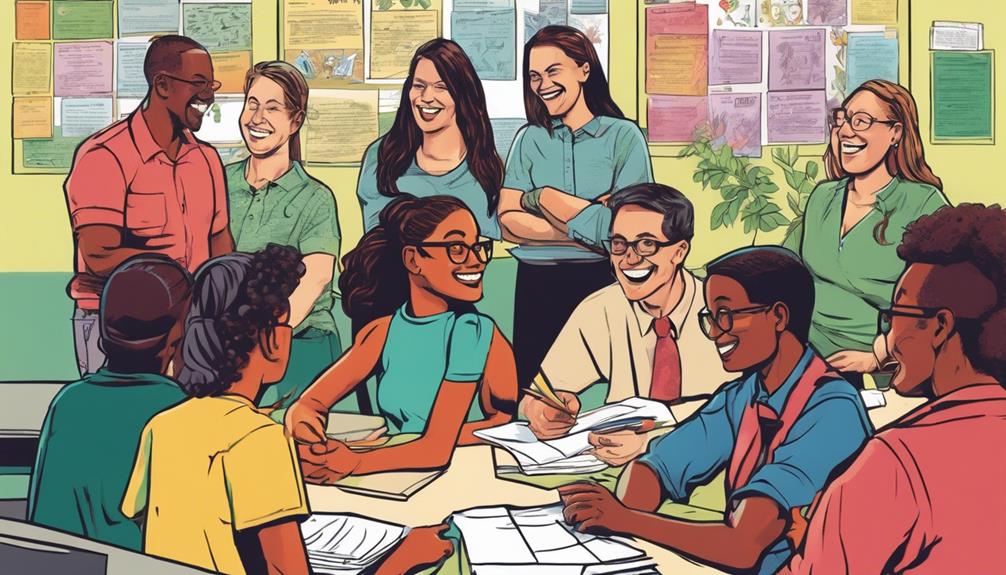Boosting teachers’ happiness leads to classroom success by focusing on **well-being**, **positive relationships**, and **professional growth**. Start with well-being: practice daily meditation, and accept student behavior. Build strong connections by spending time with colleagues and loved ones, creating a supportive environment. Dive into workshops, and conferences, and collaborate with peers. Seek mentorship, share experiences, and read educational literature to enhance teaching skills. **Prioritizing these aspects** helps teachers foster a thriving and positive classroom atmosphere. **Discover how these tactics can lead to greater classroom success**.
Key Takeaways
- Prioritize teacher well-being through emotional support and mindfulness practices.
- Foster positive relationships with colleagues and students for a conducive environment.
- Engage in continuous professional development for growth and improved teaching practices.
- Cultivate acceptance for student behavior to effectively manage classroom dynamics.
- Create a supportive environment through connections, sharing experiences, and seeking mentorship.
Enhancing Teacher Well-being
By prioritizing emotional well-being and fostering positive relationships, we, as teachers, can enhance our overall happiness and effectiveness in the classroom. Cultivating acceptance for students' behavior and focusing on our own happiness are essential steps.
Playing with students not only increases our connection with them but also enhances classroom management. Engaging in daily meditation promotes a calm and relaxed mindset, breaking the cycle of unhappiness.
Taking short walks boosts our physical and mental health, inducing positive feelings through exercise. These practices contribute to a more positive teaching experience and help us handle challenges effectively.
Through prioritizing emotional well-being and nurturing positive relationships, we create a conducive environment for both ourselves and our students to thrive.
Fostering Positive Relationships

Cultivating strong connections with colleagues and loved ones is essential for fostering positive relationships in the educational setting. Spending time with coworkers and family members can create a supportive environment that enhances well-being.
Making friends with fellow teachers can lead to positive emotions, thanks to the release of oxytocin, a hormone associated with bonding. By sharing experiences and feelings with others, teachers can increase their happiness levels at work.
These relationships can provide a sense of belonging, reduce feelings of isolation, and offer emotional support during challenging times. Building positive connections not only benefits individual teachers but also contributes to a more collaborative and uplifting school culture overall.
Promoting Professional Development

Teachers can enhance their skills and knowledge through promoting professional development opportunities. Attending workshops, conferences, and seminars can provide valuable insights and strategies for improving teaching practices.
Collaborating with colleagues and participating in peer observations can offer new perspectives and ideas. Engaging in online courses and reading educational literature can help stay current with the latest trends and research in education.
Seeking mentorship from experienced educators can provide guidance and support for professional growth. Reflecting on teaching practices and setting personal goals can further drive professional development.
Frequently Asked Questions
How Can Teachers Effectively Handle Disruptive Student Behavior?
We manage disruptive student behavior by staying calm, setting clear expectations, and addressing issues promptly. We build positive relationships, use proactive strategies, and seek support when needed. Together, we create a conducive learning environment for all.
What Strategies Can Teachers Use to Support Students With Mental Health Issues?
To support students with mental health issues, we prioritize open communication, offer understanding, and provide resources. We create a safe space, listen actively, and collaborate with mental health professionals. Together, we foster a supportive environment for students' well-being.
Is It Important for Teachers to Have Hobbies Outside of Work?
Having hobbies outside of work is like planting seeds in a garden – it nourishes our souls and fuels our passion. Hobbies bring balance, joy, and rejuvenation to our lives, enhancing our well-being and resilience.
How Can Teachers Create a More Inclusive Classroom Environment?
To create a more inclusive classroom environment, we prioritize listening to all students, fostering open communication, and celebrating diversity. By embracing empathy, understanding different perspectives, and promoting respect, we cultivate a welcoming space for everyone.
What Role Does Self-Reflection Play in Teacher Growth and Development?
Self-reflection is pivotal for our growth and development as teachers. It allows us to assess our practices, identify areas for improvement, and continuously aim to be better educators. It fosters self-awareness and drives professional excellence.
Conclusion
Ultimately, prioritizing teacher well-being is essential for creating a positive classroom environment and fostering student success. By focusing on self-care, building strong relationships, and pursuing professional development, educators can enhance their teaching practices and overall job satisfaction.
For example, when a teacher regularly practices mindfulness techniques and maintains a healthy work-life balance, they're better equipped to handle challenging situations in the classroom and provide effective support for their students.











